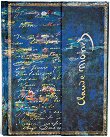Master of the sublime: The essential Impressionist. ... No other artist, apart from J.M.W. Turner, tried as hard as Claude Monet (1840 - 1926) to capture light itself on canvas. Of all the Impressionists, it was the man Cezanne called "only an eye, but my God what an eye!" who stayed true to the principle of absolute fidelity to the visual sensation, painting directly from the object. It could be said that Monet reinvented the possibilities of color. Whether it was through his early interest in Japanese prints, his time as a conscript in the dazzling light of Algeria, or his personal acquaintance with the ... |
|
It was a dappled and daubed harbor scene that gave Impressionism its name. When Impression, Sunrise by Claude Monet was exhibited in April 1874, critics seized upon the work's title and its loose stylistic rendering of light and motion upon water to deride this new, impressionistic, tendency in art. As with many seminal art movements, the critics got their comeuppance. Today, Impressionism is close contender for the world's favorite period of painting. With blockbuster exhibitions, record-breaking auction prices, and packed museums, the works once dismissed as unfinished or imprecise are now beloved for their ... |
|
Manet called him "the greatest painter of all." Picasso was so inspired by his masterpiece "Las Meninas" that he painted 44 variations of it. Francis Bacon painted a study of his portrait of Pope Innocent X. Monet and Renoir, Corot and Courbet, Degas and Dalí... for so many champions of art history, the ultimate soundboard was - and remains - Diego Rodríguez de Silva y Velázquez (1599-1660). This updated catalog raisonné brings together Velázquez’s complete works, jaw-droppingly reproduced in extra-large format, with a selection of enlarged details and brand new photography of ... |
|
Следват резултати с по-слабо съвпадение на търсеното: |
Тефтерът Monet от колекцията Embellished Manuscripts Collection на Paperblanks представя една от многото картини с водни лилии на френския художник импресионист Клод Моне. Уникалният дизайн с твърда корица ще потопи всеки в невероятния свят на изкуството. Съдържа 144 нелинирани страници от устойчива хартия, без съдържание на киселини. Тефтерът е подходящ за записване на задачи, идеи, напомняния и водене на всякакви бележки. Разполага с текстилна лента за отбелязване. От вътрешната страна, на задната корица на тефтера, има джоб, в който може да съхраняване важни бележки или малки по размер, но не и по значение спомени. ... |
|
Multilingual Edition (English, French, German). ... A tour of contemporary home decor around the world. With an inspirational richness and diversity of styles, these homes, residences, hideaways, and studios will astound and astonish, no matter the taste; be it rustic country cottage, New York-style loft, or bohemian bungalow. This survey of contemporary interior design carefully curates homes from all over the world - from Auckland, New Zealand, to Avignon, France. Mapped out through hundreds of images by renowned interior photographers, these gorgeous houses offer inspiration and ideas for your next renovation. Many ... |
|
Изданието е триезично - на английски, немски и френски език. ... Originally published in France between 1876 and 1888, Auguste Racinet's Le Costume historique was in its day the most wide-ranging and incisive study of clothing ever attempted. Covering the world history of costume, dress, and style from antiquity through to the end of the 19th century, the six volume work remains completely unique in its scope and detail. This Taschen reprint presents Racinet's exquisitely precise color illustrations, as well as his delightful descriptions and often witty commentary. Spanning everything from ancient Etruscan ... |
|
Henri Rousseau (1844 - 1910) was a clerk in the Paris customs service who dreamed of becoming a famous artist. At the age 49, he decided to give it a try. At first, Rousseau’s bright, bold paintings of jungles and exotic flora and fauna were dismissed as childish and simplistic, but his unique and tenacious style soon won acclaim. After 1886, he exhibited regularly at Paris’s prestigious Salon des Indépendants, and in 1908 he received a legendary banquet of honor, hosted by Picasso. Although best known for his tropical scenes, Rousseau, in fact, never left France, relying on books and magazines for inspiration, as ... |
|
Multilingual Edition: English, French, German. ... Time-travel through the Automobile Age with a collection that puts you in the driver’s seat. 20th Century Classic Cars offers a lush visual history of the automobile, decade by decade, via 400-plus print advertisements from the Jim Heimann Collection. Using imagery culled from a century of auto advertising, this book traces the evolution of the auto from horseless carriage to rocket on wheels and beyond. With an introduction and chapter text by New York Times automotive writer Phil Patton, as well as an illustrated timeline, this volume highlights the technological ... |
|
Updated Edition. ... This handy, updated edition explores the Bauhaus School of Art and Design through some 575 illustrations and biographies of its key personalities. Realized in collaboration with the Bauhaus-Archiv in Berlin, the reference work is now available in Bibliotheca Universalis format, the perfect companion for your next trip to Berlin, Weimar, or Dessau. In a fleeting 14-year period between two world wars, Germany’s Bauhaus school of art and design changed the face of modernity. With utopian ideas for the future, the school developed a pioneering fusion of fine art, craftsmanship, and technology, which ... |
|
Andy Warhol (1928 - 1987) is hailed as the most important proponent of the Pop art movement. A critical and creative observer of American society, he explored key themes of consumerism, materialism, media, and celebrity. Drawing on contemporary advertisements, comic strips, consumer products, and Hollywood’s most famous faces, Warhol proposed a radical reevaluation of what constituted artistic subject matter. Through Warhol, a Campbell’s soup can and Coca Cola bottle became as worthy of artistic status as any traditional still life. At the same time, Warhol reconfigured the role of the artist. Famously stating "I ... |
|
The rebel hero of Abstract Expressionism, Jackson Pollock (1912 - 1956) careened through his life like a firework across the American art landscape. Channeling ideas from sources as diverse as Picasso and Mexican surrealism, he rejected convention to develop his own way of seeing, interpreting, and expressing. Pollock’s most famous works are his drip paintings, where he dripped and poured household enamel paint over the canvas with a variety of instruments, from sticks to syringes, hardened brushes to broken bits of glass. The splattered results pulsate with energy, replacing the refinement of easel and brush with ... |
|
There are over 1,000 catalogued works by Sir Peter Paul Rubens (1577 - 1640), the 16th-century flag bearer for Baroque drama, movement, and sensuality. This essential introduction takes in the most important works from this astonishingly prolific oeuvre to explore Rubens’s influences and innovations, and his remarkable visual, and art historical, impact. The richly illustrated survey takes in Rubens’s portraits, landscapes, and historical paintings, as well as his famed and bountiful nudes. Along the way, we examine the artist’s astonishing technique and his deft ability to depict narrative in a compelling and legible ... |












